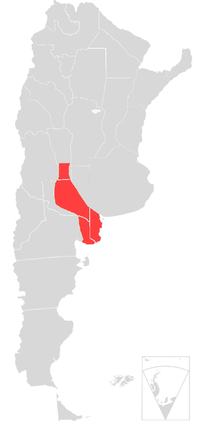
Photo from wikipedia
Abstract. Three different models (STEP–GENDEC–NOflux, Zhang2010, and Surfatm) are used to simulate NO, CO2, and NH3 fluxes at the daily scale for 2 years (2012–2013) in a semi-arid grazed ecosystem… Click to show full abstract
Abstract. Three different models (STEP–GENDEC–NOflux, Zhang2010, and Surfatm) are used to simulate NO, CO2, and NH3 fluxes at the daily scale for 2 years (2012–2013) in a semi-arid grazed ecosystem at Dahra (15∘24′10′′ N, 15∘25′56′′ W, Senegal, Sahel). Model results are evaluated against experimental results acquired during three field campaigns. At the end of the dry season, when the first rains re-wet the dry soils, the model STEP–GENDEC–NOflux simulates the sudden mineralization of buried litter, leading to pulses in soil respiration and NO fluxes. The contribution of wet season fluxes of NO and CO2 to the annual mean is respectively 51 % and 57 %. NH3 fluxes are simulated by two models: Surfatm and Zhang2010. During the wet season, air humidity and soil moisture increase, leading to a transition between low soil NH3 emissions (which dominate during the dry months) and large NH3 deposition on vegetation during wet months. Results show a great impact of the soil emission potential, a difference in the deposition processes on the soil and the vegetation between the two models with however a close agreement of the total fluxes. The order of magnitude of NO, NH3, and CO2 fluxes is correctly represented by the models, as well as the sharp transitions between seasons, specific to the Sahel region. The role of soil moisture in flux magnitude is highlighted, whereas the role of soil temperature is less obvious. The simultaneous increase in NO and CO2 emissions and NH3 deposition at the beginning of the wet season is attributed to the availability of mineral nitrogen in the soil and also to microbial processes, which distribute the roles between respiration (CO2 emissions), nitrification (NO emissions), volatilization, and deposition (NH3 emission/deposition). The objectives of this study are to understand the origin of carbon and nitrogen compounds exchanges between the soil and the atmosphere and to quantify these exchanges on a longer timescale when only a few measurements have been performed.
Journal Title: Biogeosciences
Year Published: 2019
Link to full text (if available)
Share on Social Media: Sign Up to like & get
recommendations!